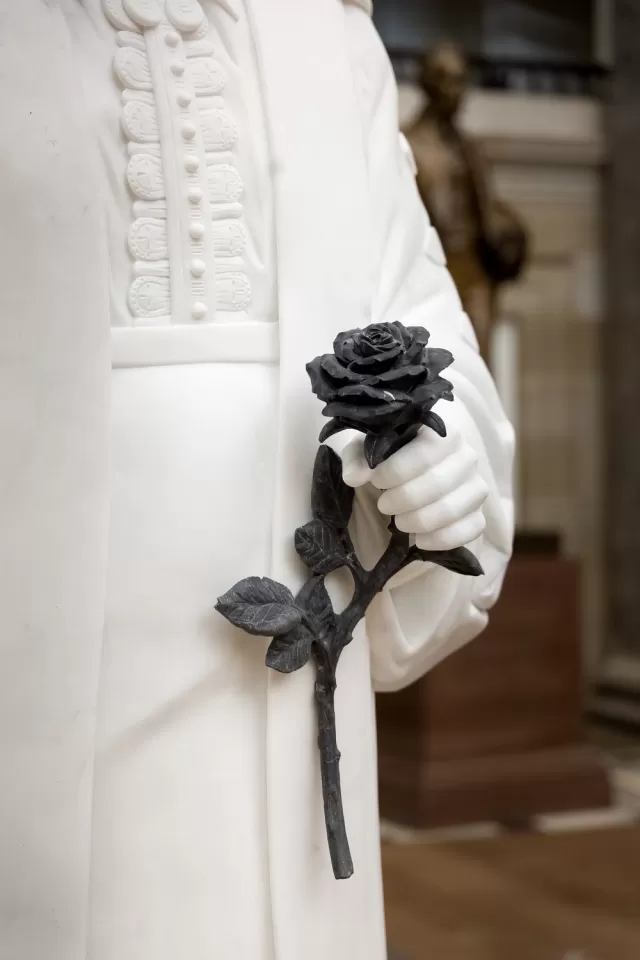Image Gallery

This statue of Bethune was given to the National Statuary Hall Collection by Florida in 2022. Nilda Comas is the first artist of Puerto Rican descent commissioned to sculpt a statue for the National Statuary Hall Collection.
Comas depicts an imposing, mature Bethune looking slightly downward, as though at a child. Her benevolent smile conveys her determined yet gentle demeanor. She holds a walking stick in her right hand and a black marble rose in her left, and she wears academic garb, including a mortarboard cap and tassel and a long robe. A dress with embroidered collar and lace details and a simple pearl necklace are visible below the open robe. Her shoes, with laces and sturdy heels, evoke pairs she wore when photographed in similar attire.
The three bands on each sleeve of her robe indicate doctoral status: Bethune was awarded nine honorary doctorates. Bethune believed that learning—especially literacy—was the key to a better life for African Americans. She founded the Daytona Normal and Industrial Institute for Negro Girls in Daytona in 1904. In just two years, Bethune expanded her school from five to 250 students. That school eventually became Bethune-Cookman College (since 2007, Bethune-Cookman University); Bethune served as its president until 1942. She co-founded the United Negro College Fund in 1944.
According to the Dr. Mary McLeod Bethune Statuary Project, the black marble rose in Bethune's left hand "symbolizes her belief that 'loving thy neighbor' means interracial, inter-religious and international brotherhood." She developed friendships with both First Lady Eleanor Roosevelt and President Franklin D. Roosevelt, serving as a policy advisor to both. As part of the U.S. delegation, she was the only Black woman at the 1945 founding conference of the United Nations. In the private sector, she was the founding president of the National Council of Negro Women; she served as vice president of the National Association for the Advancement of Colored Persons (NAACP) and as an officer in many other organizations. Bethune first saw a Black Velvet Rose in a Swiss garden, growing intermingled with roses of other colors. It inspired reflections on diversity, individuality, and peaceful interracial growth, and she began to refer to the students at her college as "black roses." This rose, made of black marble from Spain, was carved and polished separately and then attached to the statue.
Her right hand rests atop a walking stick once owned by President Roosevelt. Bethune collected walking sticks—she appreciated the style and respect they conveyed but didn't require them for mobility—and Eleanor Roosevelt sent this one to Bethune after the president’s death. Its inclusion in this statue references Bethune's participation in Roosevelt's government and her role organizing the so-called "Black Cabinet" of advisors, the Federal Council of Negro Affairs. Comas chose to depict Bethune at about 70 years old, an age when she would have already worked in Washington, D.C., with a confident bearing and satisfaction regarding her accomplishments.
The pile of books stacked casually behind Bethune's feet reference her last will and testament. The top book's cover reads "I Leave You", and the lower spines name some of the values listed in her will: "Love / A Thirst for Education / Faith / Racial Dignity / Hope / Peace / Courage." The books also help balance the weight of the statue.
The statue is made of Italian Carrara marble; Comas carved it in Pietrasanta, Italy, near the mountains where the marble was quarried. It is the first marble statue to enter the National Statuary Hall Collection since 2005, and only the second since 1963.
The pedestal is made from the same white marble, and its design is classically inspired. Carved into the marble and highlighted in gold is the inscription:
FLORIDA
Dr. Mary McLeod Bethune
1875-1955
"Invest in the human soul. Who knows, it might be a diamond in the rough."
The combined statue and pedestal are 11 feet tall and weigh 6,129 pounds. A bronze statue made from the models Comas produced for the marble statue will be displayed at a park in Daytona Beach, Florida, near Bethune-Cookman University.
Bethune is the first African American represented in the National Statuary Hall Collection.
Sculptor Nilda M. Comas (1953– ) was born in San Juan, Puerto Rico. In childhood, she enjoyed copying oil paintings at the Museo de Arte de Ponce; she holds bachelor's and master's degrees in fine arts. She did postgraduate work at Italy's Accademia di Belle Arti di Carrara, and has studied and apprenticed with sculptors in marble and in bronze. She has won medals and awards from the National Sculpture Society in New York and the Society of Women Artists in London, and her works are in public and private collections in the United States, Europe, and South America. She maintains studios in Pietrasanta, Italy and Fort Lauderdale, Florida, where she teaches, sculpts, and paints. Her public artworks, primarily displayed in Florida, feature a variety of subjects, including a Seminole girl and historical figures.
Comas was one of 1600 applicants for the commission to create Florida's new statue. She is the first artist of Puerto Rican descent commissioned to create a statue for the National Statuary Hall Collection. At the time she was selected, the state had yet to choose a subject for the statue. Comas works in both marble and bronze, often creating smaller models in Florida and then transporting them to Italy to enlarge. She studied photographs of Bethune as she modeled the statue and listened to recordings of Bethune's speeches. Bethune's voice suggested to Comas her qualities of confidence, gentleness, and directness.
